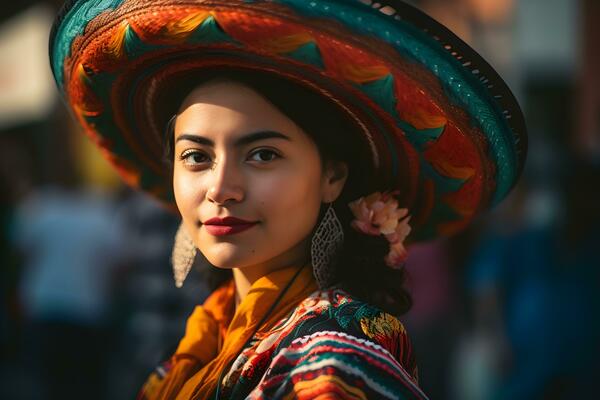The sombrero is more than only a hat; it’s miles a image of Mexican tradition, history, and identification. This extensive-brimmed hat, recognized international, has a story this is deeply intertwined with the social and cultural material of Mexico. Its evolution from a practical headgear to a cultural icon is a testament to the wealthy historical past of the Mexican human beings.
Origins and Evolution
The word “sombrero” is derived from the Spanish word “sombra,” which means color or shadow, which guidelines on the hat’s number one function: to protect its wearer from the solar. The sombrero is assumed to have originated in Spain, wherein comparable wide-brimmed hats were worn through farmers and workers to defend themselves from the acute sunlight. When the Spanish colonized the Americas, they brought the sombrero with them, and it quick have become popular in Mexico, adapting to the local climate and tradition.
In Mexico, the sombrero evolved to fit the wishes of different areas. The maximum recognizable version is the sombrero charro, that’s associated with the charros, conventional Mexican horsemen who were skilled in ranching and rodeo. The sombrero charro is normally product of felt or straw, with a wide brim that may be turned up at the rims and a high, pointed crown. It is often embellished with difficult embroidery, silver or gold thread, and different decorative factors, reflecting the status and pleasure of the wearer.
Another version is the sombrero de paja, a less difficult straw hat worn through peasants and farmers. This version is lighter and greater practical for everyday use, imparting necessary protection from the solar whilst running in the fields. The sombrero de paja is less ornate than the sombrero charro, but it remains an vital a part of Mexican rural existence.
The Sombrero in Mexican Culture
The sombrero is not simply a bit of garb; it’s far a image of Mexican identity. It is intently related to the Mexican Revolution, where it have become a symbol of the revolutionary spirit. Many of the revolutionaries, consisting of the enduring figures Pancho Villa and Emiliano Zapata, had been frequently depicted carrying sombreros, which became emblematic of the combat for justice and freedom.
The sombrero also performs a tremendous function in Mexican celebrations and traditions. It is regularly worn in the course of festivities consisting of Cinco de Mayo and Mexican Independence Day, wherein it’s far a symbol of national pleasure. The hat is likewise a staple in the conventional mariachi music ensemble, in which musicians don difficult sombreros as a part of their apparel, including to the grandeur and authenticity of their performances.
In Mexican folks dances, such as the jarabe tapatío (the Mexican Hat Dance), the sombrero is a primary detail. Dancers use the hat as a prop, incorporating it into their moves in a way this is each playful and respectful. The dance itself is a party of Mexican tradition, and the sombrero’s presence highlights its significance as a cultural image.
The Sombrero’s Influence Beyond Mexico
The have an effect on of the sombrero extends beyond Mexico’s borders. As Mexican culture unfold thru migration and globalization, the sombrero became a recognizable symbol of Mexico worldwide. It has regarded in numerous forms of media, which include films, television indicates, and cartoons, often used to depict Mexican characters or settings. While those portrayals can sometimes be stereotypical, they have also helped to cement the sombrero’s region in international famous way of life.
In america, the sombrero has been followed in various ways, in particular inside the southwestern states, where there’s a big Mexican-American population. The hat is often worn in the course of cultural festivals, parades, and other occasions celebrating Mexican background. It has also been embraced by means of the fashion industry, in which designers have incorporated elements of the sombrero into their collections, blending traditional Mexican patterns with current style trends.
However, the sombrero’s cultural importance has also caused discussions about cultural appropriation. Some argue that the sombrero have to be worn and celebrated with respect for its cultural roots, in preference to as an insignificant costume or novelty item. This debate highlights the need to apprehend and respect the history and that means at the back of cultural symbols like the sombrero.
The Craftsmanship Behind the Sombrero
Creating a sombrero is an art shape that calls for talent, persistence, and interest to detail. The manner of creating a conventional sombrero charro can take several weeks, as each hat is handcrafted by means of professional artisans. The materials used, such as felt, straw, and leather, are cautiously selected for his or her fine and durability.
The creation of the sombrero includes numerous steps. First, the brim and crown are formed the use of timber molds. The brim is then stiffened with a mixture of water and starch to hold its form. The crown is regularly bolstered with additional layers of felt or straw, imparting electricity and shape. Once the primary shape is entire, the hat is adorned with embroidery, braiding, and different elaborations. These decorations are regularly stimulated through traditional Mexican motifs, which include plants, animals, and geometric styles.
The final step is the finishing touches, which may additionally include adding a chin strap or a band across the crown. The end result is a beautifully crafted hat that is each useful and a work of artwork.
The Sombrero Today
Today, the sombrero stays an critical a part of Mexican way of life, both as a useful item and a image of country wide pride. While its sensible use has diminished in contemporary instances, the sombrero remains worn throughout cultural events, ceremonies, and celebrations. It is also a popular memento for tourists, who searching for to carry home a bit of authentic Mexican way of life.
Conclusion
In latest years, there was a renewed hobby in traditional Mexican crafts, which includes sombrero-making. Artisans are locating new ways to maintain and promote this historical craft, making sure that the way of life of sombrero-making is surpassed down to future generations. This revival has additionally caused more appreciation for the skill and craftsmanship involved in growing a sombrero, in addition to its cultural importance.
The sombrero is extra than just a hat; it’s miles a symbol of Mexico’s wealthy cultural historical past. Whether worn by way of a mariachi musician, a progressive, or a dancer, the sombrero embodies the spirit and identity of the Mexican human beings. As it remains celebrated and loved, the sombrero remains a powerful reminder of the history, traditions, and pleasure of Mexico.
For more insights and detailed articles, explore the menu on sombrero
Read more on ExposedMedia


